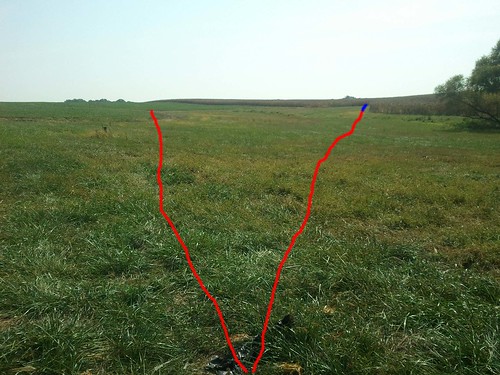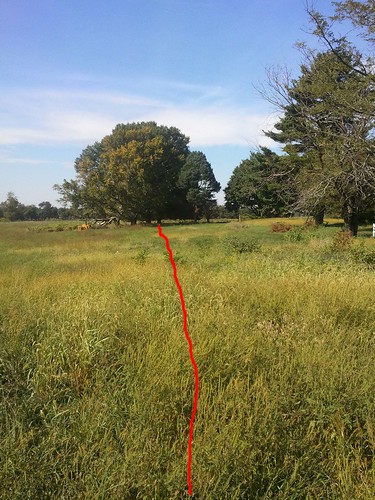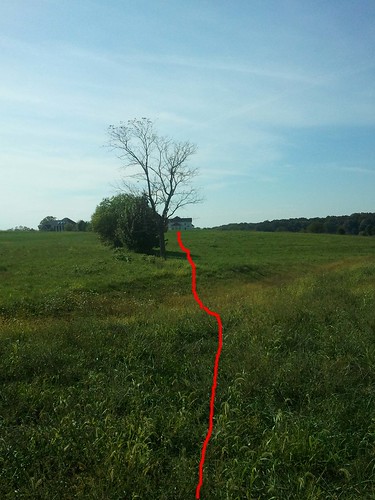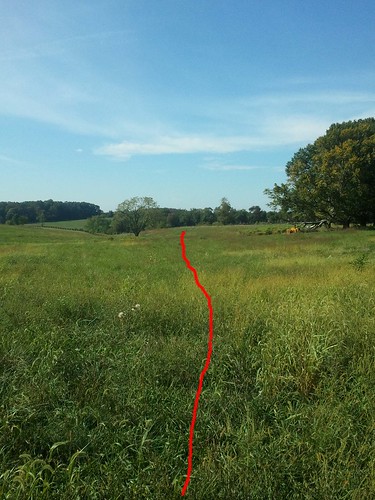In November 2007, Lindsay Ridgeway developed a series of performance tests as a method of training Lumi and Laddie, his two Golden Retrievers, for field sports. This is the journal of their progress through that series and beyond. Contact: LDRidgeway at gmail dot com.
Sunday, September 26, 2010
Reverse Hip-pocket Doubles
Friday, September 24, 2010
Triple blind
Sunday, September 19, 2010
Land blinds
Saturday, September 18, 2010
De-flaring Drill, Steps 1 and 2
Building Confidence with Singles
Monday, September 13, 2010
De-flaring Drill
Saturday, September 11, 2010
Out-of-order Indent Triples with Middle Gun Retired
- For the go-bird, that is, the 140-yard mark on the right, the dog had to accept postponing the nearer center retrieve and instead run past it 30 degrees to the right.
- For the center mark at 70 yards, the dog had to get his bearings without depending on a visible gun station.
- For the final 180-yard memory-bird on the left, the dog had to take a line only a little to the left of the retired gun (that is, the umbrella), since flaring it would put the dog on a line too far to the left.
Friday, September 10, 2010
Out-of-order Reverse Hip-Pocket Double
SERIES A. Out-of-order reverse hip-pocket double with blind (Lumi, then Laddie)
Lumi ran first and ran only the double. Laddie ran second and ran the whole series, first the double, then the blind.
The first mark of the double was on the left at 70 yards, thrown right-to-left and angled back so that it landed in cover on the far side of a rise, making the area of the fall hidden from the start line. The second mark was on the right at 140 yards, thrown right-to-left from a stickman and angled back across a ditch into cover. The line to the longer mark on the right passed a little to the right of the shorter "thrower", making this a reverse hip pocket double. The fact that the long mark was thrown as the go-bird made this an out-of-order double. Both throws were with BBs.
After Laddie picked up both marks, he ran the 260-yard blind. The line to the blind ran downhill just to the right of the stickman for the long mark, across a ditch, uphill and thru a line of trees, and across an old paved driveway.
Notes on Performance
I am more concerned these days with building Laddie's confidence than I am with pushing the envelope, but I guess this set-up was too easy. Both Lumi and Laddie nailed both marks, and Laddie ran a nice tight blind, with two clean casts.
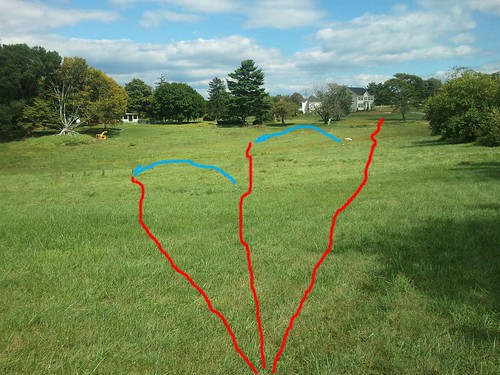
Current Training Activities
- In Patty's Field Trial group, we work on whatever her set-ups are, but my primary concern is trying to build Laddie's confidence in that context. I've come to believe that a lot of his problems on returns, which only seem to happen in group settings, come from an emotional response to the situation. I'm not sure yet whether the root cause is: Laddie picking up stress from me (which Alice and others suspect to be the case); or he is affected by the presence of other trainers, dogs, and field training gear; or, as I'm inclined to believe based on some experimentation, he's affected by set-ups that he considers too far over his head. One of his symptoms is popping. I'm hoping to use his frequency of pops as a yardstick for measuring my success in simplifying set-ups to increase Laddie's success rate, with the goal of course to eliminate popping, as well as poor returns, entirely.
- In private training and training with Gaby, we're working on a variety of concepts, varying from day to day: inline triples, hip pocket doubles in combination with a third retrieve (either a third mark or a blind run after the double is down before one or both of the marks are picked up), reverse hip pocket doubles run with a third retrieve, and out of order doubles or triples (that is, having the go-bird not be the shortest mark). In addition, we run land and water blinds, practicing things like angled water and cover entries and exits, on-and-off the point, keyholes, wraps (such as running past a hedgerow that has a field opening up behind it, tending to suck the dog behind the hedgerow), and hills. Distances of our marks are in the range of 40-300 yards. Distances of our blinds are in the range of 150-300 yards, occasionally even bigger.
- Sometimes we run drills. For example, yesterday, out of curiosity, I ran Laddie on an out-of-order double with a long blind, and then I had him do a session of pile work. For the pile work, I set up a pile of 10 bumpers (5 white, 5 black) at an LP, and ran him to it from an SL 90 yards away. He ran both directions with great enthusiasm on every retrieve. In addition, I was pleased to see that he almost never dawdled or shopped on the pick-ups. I think he may have started to shop maybe twice, and as soon as I called "Here", he immediately grabbed the bumper he'd originally picked up and streaked back to me. Other drills we've run from time to time over the last few months are the Skimming Drill with both high cover and water as the obstacles, the Cool-off Drill, and variations on the Offline Drill.
